|
Collecting Vintage Coin Machines
| By William Petrochuk
Posted August 2013
|
 |
The era of coin-operated machines is concurrent with the gasoline-powered automobile. The last quarter of the 19th century saw the commercial birth of both major industries, and the first quarter of the 21st century will probably witness their demise.
These machines continue to operate. Coins, however, are quickly being replaced by paper bills, credit cards and other new technology, while cars are quickly being converted to electric operation. Soon, society may no longer need coins to purchase anything.
|
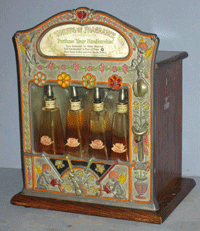
|
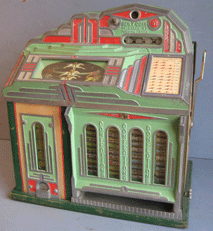
|
|
Mills Whiffs of Fragrance, Mills Novelty Company,
Chicago. This cast iron and wood vending machine
offered a choice of four fragrances for one cent.
Beautiful flowers and cupids adorned this 1916 beauty.
(Photo, courtesy of Johnny Duckworth.)
|
Superior Horse Race, Superior Confection Co., Columbus, Ohio. One of the most highly sought after slot machines from the 1930s, the goal is to line up the correct colors of horses to make a payout. Win or lose, the player always received a roll of mints. (Photo, courtesy of Johnny Duckworth.)
|
During the American Industrial Revolution, coin-op inventors produced numerous devices. The vending, amusement and gambling machine industry grew side by side with the other great inventions of this era.
Vending machines have been around longer than any other type of coin-op. They can be traced back to an ancient Egyptian holy water vendor used more than 2,200 years ago. A five-drachma coin provided a small splash of water with which a worshiper could sprinkle himself. Around 1700, pipe tobacco and snuff vendors appeared in England. In the 1880s, foreign-born inventors on American soil developed and manufactured many types of vending machines. Matches, collar buttons, chewing gum, peanuts, stamps and cigars were just a few of the multitude of items that one might purchase for a penny or nickel.
Gambling devices soon followed, and during the 1890s, the industry flourished. Originally, all coin-operated machines were called slot machines, but later, the term would be used only when referring to gambling devices.
|
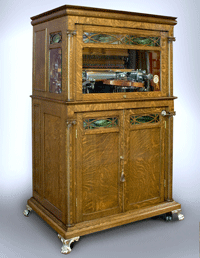
|
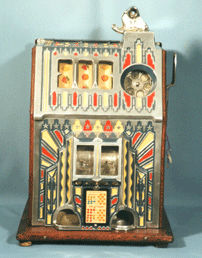
|
|
Violano Virtuoso, Mills Novelty Co., Chicago. Playing piano and a real violin in a quarter sawn oak cabinet, these mechanical wonders entertained people around the globe. Thousands of nickelodeons were produced by various manufacturers between 1910 and 1930.
(Photo, courtesy of Johnny Duckworth.)
|
Fancy Front Comet Slot Machine, Pace Mfg. Co.,
Chicago. Elaborate Art Deco aluminum castings were popular facades for slot machine in the early 1930s.
(Photo, courtesy of W. Petrochuk.)
|
The first gambling machines were based on poker, roulette and dice games. These early machines usually required a nickel in the slot to operate, but they did not pay out coins. Winning combinations were paid out in cash or merchandise by a clerk over the counter. These gambling machines were called trade stimulators.
In 1898, Charles Fey created the first three-wheel payout slot machine. The basic mechanism was copied by numerous manufacturers and remained unchanged for more than 60 years. Hundreds of thousands of “One Armed Bandits” were produced. Collecting antique slot machines is legal in most states, provided you do not use them for gambling. Collectors should check the status of their state law before purchasing.
Amusement machines also developed quickly in the 1880s. Coin-operated Edison phonographs led the way. Soon, strength testers, fortune tellers and stereoscopic card viewers led to the establishment of the first penny arcades. Penny scales, punching bags, electric shockers and more great amusements delighted operators and patrons alike.
|
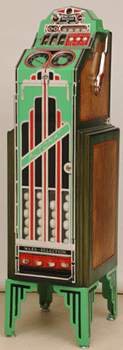
|
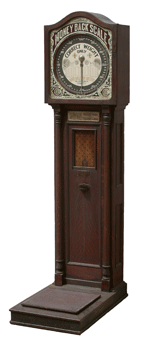
|
|
Superior Golf, Superior Confection Co., Columbus, Ohio.
This quarter-operated slot machine was built
exclusively for country clubs in 1938 and was designed
to pay out
one to four golf balls on winning combinations.
It was marketed with the promise of increasing
golf ball sales up to 500%.
(Photo, courtesy of the E. Rymer Collection.)
|
Caille Money Back Scale, Caille Bros. Mfg. Co. Detroit Michigan. Produced in the early 1900s, this penny scale told your correct weight and gave you a chance to receive your penny back—the coin traveled through a pin field and would sometimes fall into the payout cup at the bottom. (Photo, courtesy of Johnny Duckworth.)
|
The coin-op industry exploded during the 1890s and early 1900s. Machines could be found in every city and town. Tobacco shops, hotels, country stores, saloons, train stations and beach resorts became great sources of revenue for coin machine operators. World War I, however, slowed the industry. The 1920s and ‘30s, which saw the return of huge production numbers, are often called the Golden Age of coin-op.
A second war would again result in a slowdown as manufacturers were prohibited from using materials that were deemed critical for the war effort, and factories were converted to produce military goods. From 1950 to 2000, coin-op production continued to expand into a multi-billion- dollar industry.
Coin machines reflect the art forms of their production periods. This may sometimes help collectors identify the machine’s age. This is especially true for gambling machines. The earliest machines were very simple in their design. In the late 1890s, machines had Victorian lines. This would give way to the straight-lined Eastlake décor. After the turn of the 20th century, designs were marked by art nouveau and that would later switch to geometric art deco. Modernism prevailed and dominated most all production after 1940.
Gambling machines from the late 1800s and before 1915 usually trade in the four- to five-figure range. Some rare machines occasionally sell for up to $250,000. Most machines manufactured from 1920 to 1950 go for a few hundred to several thousand dollars. Modern electromechanical and digital slots seldom sell for more than a few hundred dollars.
|
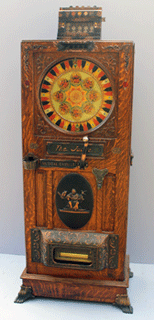
|
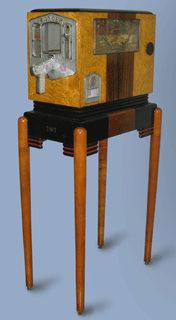
|
|
Musical Judge Upright One-Wheel Slot Machine, Mills Novelty Co., Chicago. A Swiss music box played a contemporary air when a coin was dropped, giving you something for your money to challenge the anti-gambling laws. Quarter sawn oak cabinets with cast iron trim graced many styles of large one-wheel wonders made between the 1890s and 1930.
(Photo, courtesy of Johnny Duckworth.)
|
Ranger Arcade Gun Game, Bally Mfg. Co., Chicago.
Pistol and rifle games were among the first arcade
skill games made. This one is from the 1920s.
(Photo, courtesy of Johnny Duckworth.)
|
Arcade and vending machines were more brightly painted and evolved to a carnival-style look. Their age can usually be judged by the coin denomination, with early machines being penny-operated and later ones requiring nickels. The earliest machines employed cast iron, mahogany and quarter sawn oak in their cabinetry, while later machines used aluminum and lesser quality woodworking.
Arcade machines from the turn of the last century sell regularly in the four- to five-figure range. Most of the very old vendors sell for $500 to $15,000. Although there are exceptions, arcade and vending machines made after 1935 sell for $50 to $2,000.
The number of coin-op collectors worldwide is estimated to be in the low thousands. This is partially due to the scarcity of available machines on the market. These machines were originally sold to the operators rather than to the public that used them. Machines were seldom put up in someone’s attic like most other antiques.
For the most part, these machines were seen as utilitarian money makers by their owners; once they came into disrepair, they were discarded and replaced with newer models. “Evil gambling machines” were often destroyed by law enforcement. Arcade machines endured the constant abuse of children. A vending machine was no longer considered useful when price changes were required or products were redesigned.
|
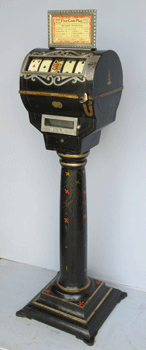
|
Jumbo Success Trade Stimulator, Mills Novelty Company, Chicago. More than a dozen makers produced these large cast iron poker machines in the early 1900s. Winning hands resulted in “FREE Drinks or Cigars.” Most were located in saloons. (Photo, courtesy of Johnny Duckworth.)
|
The Coin Op Collectors Association (COCA) is an international collectors club dedicated to collecting, restoring and preserving these machines and their history. With more than 700 members, the club continues to grow as younger folks discover these fascinating devices. The COCA website, www.CoinOpClub.org, is a great source of knowledge for anyone interested in coin-op.
Ken Rubin, a member of the COCA Hall Of Fame and author of the first definitive coin-op book published in 1979, Drop Coin Here, is considered to be one of the most widely recognized authorities on coin-op machines and their history. In a recent interview, I asked him to offer his outlook on the view of a coin-op collector.
“The hobby of collecting antique coin-operated machines has grown as more people recognize the exciting qualities these machines possess. As an art form, they cover the period from 1885 to about 1950. Within this period, the diversity of style and function is extraordinary. The charm, beauty, and character found in these objects as works of art would in themselves be enough to make them treasures.
“But antique coin machines offer a great deal more. They accept our coins and perform as willingly today as when they first appeared. They elicit a sense of nostalgia that conjures up memories of naïve days and simple pleasures. They invite the attention of the craftsman and the mechanic to keep them in presentable and operating condition. They are fun, unique artifacts of America’s cultural past.”
Ken is currently working on his new, soon-to-be-published book, Silent Cigar Salesmen, The History of Cigar Vending Machines.
----------------------
Bill Petrochuk has been an avid collector of coin-op machines since the 1970s. He is a past president of the Coin Op Collectors Association and is currently serving as the editor of the club’s website. Contact him at www.coinopclub.org/contact.
|